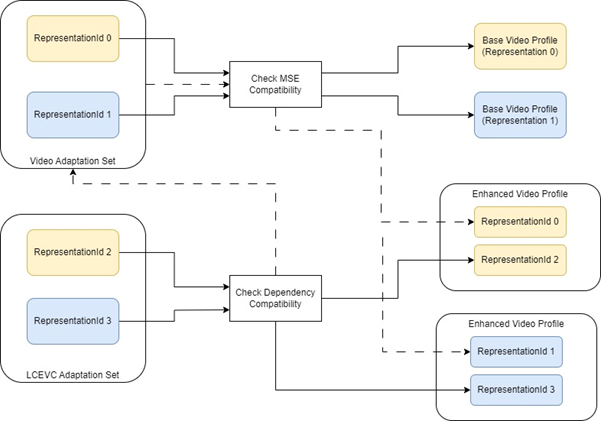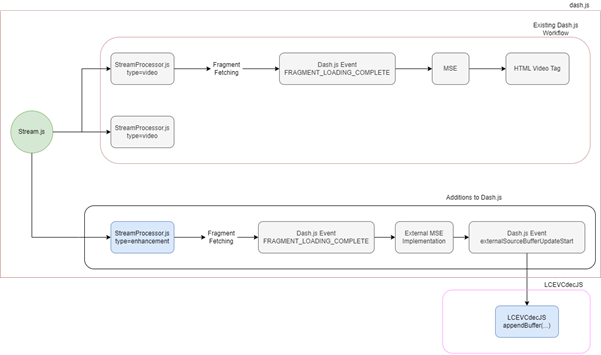Scalable LCEVC in dash.js
Introduction

This approach creates LCEVC representations which are dependent upon native codec representations (by using dependencyId). LCEVC enhancement representations are contained in a 2nd Adaptation Set and linked to the base representations in the 1st Adaptation Set. The outcome is the ability to play adaptive streaming content where one or more higher resolution profiles are generated by applying LCEVC enhancement to existing conventional profiles saving up to 70% bitrate compared to using conventional standalone native profiles.
An external implementation of the MSE classes MediaSource and SourceBuffer is provided to interject the calls from the enhancement representations. The external SourceBuffer implementation triggers events on buffers appended and removed which the external libraries can listen to.

Sample player
An example player is available at https://reference.dashif.org/dash.js/nightly/samples/lcevc-dual-track/lcevc-dual-track.html
Manifest format
A separate AdaptationSet is added, alongside the backward compatible video AdaptationSet with the base codec Representations, comprising only the LCEVC Representations with dependencyId that corresponds to the associated base representation. The AdaptationSet of the dependent representations would have the following attributes:
- @contentType = ‘video’
- @mimeType = ‘video/mp4’
- @codecs = ‘lvc1’
- @frameRate = «frameRate of base representation»
- @dependencyId = «representationId of base representation»
- @width/height = <LCEVC enhanced video width/height>
- @bandwidth = <combined bit rate of the LCEVC + base representation>
- @sar = <sample aspect ratio as signalled in LCEVC Video Usability Information (VUI)>
Example manifest
Sample manifest is available at https://s3.eu-west-1.amazonaws.com/origin-prod-lon-v-nova.com/lcevcDualTrack/1080p30_3Mbps_no_dR/master.mpd
<?xml version="1.0" encoding="utf-8"?>
<MPD
xmlns:xsi="http://www.w3.org/2001/XMLSchema-instance"
xmlns="urn:mpeg:dash:schema:mpd:2011"
xsi:schemaLocation="urn:mpeg:dash:schema:mpd:2011 http://standards.iso.org/ittf/PubliclyAvailableStandards/MPEG-DASH_schema_files/DASH-MPD.xsd"
type="static"
mediaPresentationDuration="PT10M34.600S"
maxSegmentDuration="PT3S"
minBufferTime="PT10S"
profiles="urn:mpeg:dash:profile:isoff-live:2011,urn:hbbtv:dash:profile:isoff-live:2012">
<Period
id="1"
duration="PT10M34.600S">
<BaseURL>dash/</BaseURL>
<AdaptationSet
id="1"
group="1"
contentType="audio"
segmentAlignment="true"
audioSamplingRate="44100"
mimeType="audio/mp4"
codecs="mp4a.40.2"
startWithSAP="1">
<AudioChannelConfiguration
schemeIdUri="urn:mpeg:dash:23003:3:audio_channel_configuration:2011"
value="2" />
<Role schemeIdUri="urn:mpeg:dash:role:2011" value="main" />
<SegmentTemplate
timescale="44100"
initialization="out-sorted-$RepresentationID$.dash"
media="out-sorted-$RepresentationID$-$Time$.dash">
<SegmentTimeline>
<S t="0" d="9216" />
...
<S d="62221" />
</SegmentTimeline>
</SegmentTemplate>
<Representation
id="audio=64468"
bandwidth="64468">
</Representation>
</AdaptationSet>
<AdaptationSet
id="2"
group="2"
contentType="video"
par="16:9"
segmentAlignment="true"
width="960"
height="540"
sar="1:1"
frameRate="30"
mimeType="video/mp4"
codecs="avc1.64001F"
startWithSAP="1">
<SupplementalProperty
schemeIdUri="urn:mpeg:dash:adaptation-set-switching:2016"
value="3" />
<Role schemeIdUri="urn:mpeg:dash:role:2011" value="main" />
<SegmentTemplate
timescale="600"
initialization="out-sorted-$RepresentationID$.dash"
media="out-sorted-$RepresentationID$-$Time$.dash">
<SegmentTimeline>
<S t="0" d="120" />
...
<S d="1100" />
</SegmentTimeline>
</SegmentTemplate>
<Representation
id="video=1510172"
bandwidth="1510172"
scanType="progressive">
</Representation>
</AdaptationSet>
<AdaptationSet
id="3"
group="2"
contentType="video"
par="16:9"
segmentAlignment="true"
width="1920"
height="1080"
sar="1:1"
mimeType="video/mp4"
codecs="lvc1"
startWithSAP="1">
<SupplementalProperty
schemeIdUri="urn:mpeg:dash:adaptation-set-switching:2016"
value="2" />
<Role schemeIdUri="urn:mpeg:dash:role:2011" value="main" />
<SegmentTemplate
timescale="15360"
initialization="out-sorted-$RepresentationID$.dash"
media="out-sorted-$RepresentationID$-$Time$.dash">
<SegmentTimeline>
<S t="0" d="3072" />
...
<S d="28160" />
</SegmentTimeline>
</SegmentTemplate>
<Representation
id="video_1=1544000"
bandwidth="3054172"
dependencyId="video=1510172"
frameRate="30"
mimeType="video/mp4"
scanType="unknown">
</Representation>
</AdaptationSet>
</Period>
</MPD>
Encoding LCEVC-enhanced content with ffmpeg
Instructions on how to use ffmpeg to encode LCEVC are available here https://docs.v-nova.com/v-nova/lcevc/reference-applications/ffmpeg.
Example script to generate scalable LCEVC for MPEG-DASH delivery
LD_LIBRARY_PATH=./ffmpeg ./ffmpeg/ffmpeg.exe -y -i bbb_sunflower_2160p_30fps_normal.mp4 -c:v lcevc_h264 -base_encoder x264 -strict -2 -acodec aac -ar 44100 -ac 2 -ab 64k -b:v 3000000 -g 60 -separate_track 1 -eil_params "rc_pcrf_base_prop=0.65;encoding_debug_residuals=1" -pix_fmt yuv420p -r 30 -s 1920x1080 out1.mp4
# Generate .ismv file out of the encodes.
mp4split -o out-sorted.ismv \
out1.mp4
# Generate .ism manifest from the ismv file.
mp4split -o out-sorted.ism \
out-sorted.ismv
# Generate dash files locally this should generate a manifest.mpd
mp4split \
--store-mpd \
-o manifest.mpd \
out-sorted.ism
# Generate Final manifest with addition of dependencyID and supplemental properties
manifest_edit \
-o finalManifest.mpd \
--python_pipeline_config=/etc/manifest-edit/conf/mpd/default.yaml \
out-sorted.mpd